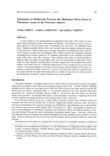Infestation of Meliaceous Trees by the Mahogany Shoot Borer in Plantation Areas of the Peruvian Amazon
JIRCAS international symposium series
| ISSN | 13406108 |
|---|---|
| 書誌レコードID(総合目録DB) | AA1100908X |

本文フルテキスト
intlsymp-1_163-171.pdf288.78 KB
A large number of tree species planted on degraded forest lands in the tropics are presently being threatened by many forest pests and diseases. Tree damage occurs not only on monocultural but also on various types of plantations over vast areas. The mahogany shoot borer, Hypsipyla grandella Zeller, is the most harmful insect pest against meliaceous species in South America. Field surveys on tree damage conducted in the plantation areas of the Peruvian Amazon revealed that both Spanish ceder (Cedrela odorata) and mahogany (Swietenia macrophylla) were heavily infested by H. grandella, particularly, in line planting and opened areas within three years after planting. Other planting trials, such as mixed planting or planting under the canopy of surrounding trees, were also unsuccessful in most cases. Trees under low light intensity, including those in natural regeneration, have escaped from initial attacks of the insect pest for a relatively longer period of time, though the tree growth was reduced. Frequent sprouting (3 to 5.5 times a year) induced repeated attacks of the insect, resulting in regeneration failure of the tree. However, since the insect density is reduced in the dry season and that the adult moth seldom flies at a height of more than 8 m above ground, the development of effective control measures may become possible.
| 作成者 | Toshiya IKEDA Akihiko TAKETANI Akihiko YOKOTA |
|---|---|
| 公開者 | Japan International Research Center for Agricultural Sciences |
| オンライン掲載日 | |
| 号 | 1 |
| 開始ページ | 163 |
| 終了ページ | 171 |
| 言語 | eng |
